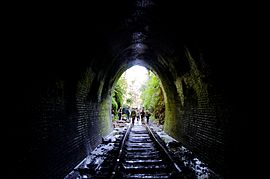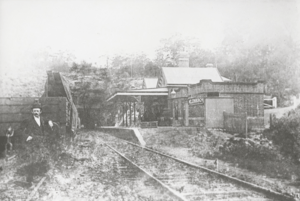Helensburgh Glow Worm Tunnel facts for kids
 |
|
| Helensburgh Tunnel, in 2017 | |
| Overview | |
|---|---|
| Line | South Coast Line (subsequently deviated) |
| Coordinates | 34°10′39″S 150°59′36″E / 34.177544°S 150.993464°E |
| Operation | |
| Closed | 1915 (as railway tunnels) |
| Owner | Government of New South Wales |
| Operator | Helensburgh Landcare |
| Technical | |
| Length | 624 metres (2,046 ft) |
| Gauge | 4 ft 8 1⁄2 in (1,435 mm) standard gauge |
The Helensburgh Glow Worm tunnel is a fascinating old railway tunnel in Helensburgh, New South Wales. It has become a very popular spot for visitors. People love it because of its interesting history and, most importantly, its amazing population of glow worms.
The tunnel is owned by the government's Crown Lands. It is looked after by a local community group called Helensburgh Landcare. In early 2019, this group limited access to the tunnel. This was done to help protect the delicate glow worm colony. As of February 2020, the tunnel was closed for a while. This closure was due to heavy flooding and to give the glow worms more time to recover.
Contents
History of the Helensburgh Tunnel
The Helensburgh Glow Worm tunnel first opened on 1 January 1889. It was an important part of the town's first railway station. The original station had two single-line tunnels. One was a short tunnel called 'Helensburgh tunnel', which was about 80 metres (88 yards) long. The other was the 'Metropolitan tunnel', which was much longer at about 624 metres (682 yards). Today, the Metropolitan tunnel is known as the 'Helensburgh Glow Worm tunnel'.
The Metropolitan tunnel connected a local coal mine to Helensburgh station. This allowed coal to be transported uphill. From there, it could be sent to suburbs north of Helensburgh.
Tunnel Closure and New Uses
The tunnels and station closed in 1915. This happened because the train line was updated. It was made into a double line to make the journey from Sutherland to Wollongong easier. This change was needed because coal mining in Helensburgh and along the South Coast was growing.
With the two tunnels no longer used for trains, the coal mine found a new purpose for the Metropolitan tunnel. They turned it into a reservoir to store water for mining. In May 1928, a concrete plug was put at the southern end of the tunnel. This helped the mine control the water that would fill the tunnel from the northern end.
Restoration Efforts by Landcare
In April 1995, the Metropolitan Colliery decided to clear out years of dirt and plants. This was done at the northern entrance of the tunnel. After removing 2 metres (7 feet) of soil, they found bricks from the original station platform. The Helensburgh Landcare group wanted to dig up the site. The colliery gave them permission to dig down to the original train track level.
In 2001, Helensburgh Landcare received a special grant. This money helped them turn the site into a historical attraction. To make the tunnel look like it used to, they laid down ballast (small stones). They also put parts of the original train track back in place. These tracks came from the colliery side of the tunnel. Landcare also fixed up what was left of the original 'Helensburgh Station' sign. They found it in a nearby valley.
Over the years, many people visited the site. Locals, historians, tourists, and photographers came. So did colonies of glow worms. In 2012, the station sign was damaged. It was removed, fixed, and put back in 2015. But within 18 months, the sign was damaged again.
In June 2018, a fence and gate were put up at the site. This was to stop vandalism and protect the area. It also helped protect the glow worm colony.
New Management and Conservation
On 21 December 2018, the NSW Government created a new reserve. This meant the Metropolitan Tunnel and Helensburgh Tunnel were set aside for "passive recreation, heritage purposes, environmental protection." Crown Lands still owned the tunnels. However, the Helensburgh and District Landcare Group Inc. became the managers. This gave them responsibility for the tunnels. Their first action was to officially name the reserve 'Helensburgh Station Reserve'.
In early 2019, the group decided to close the Metropolitan tunnel. From January 7 to February 3, they locked the fence. This blocked access to the tunnel for conservation.
Local Legends and Mystery
The Metropolitan and Helensburgh tunnels have become popular for people interested in ghost stories. Some visitors say they feel strange or have unusual experiences after visiting the tunnels. This is linked to a local legend about a miner named Robert Hails. He died in a train tunnel on 13 June 1895. He was hit by a train while walking through the tunnel.
It's not clear exactly which of the seven tunnels on the line he died in. Different news reports from the time gave conflicting locations. For example, the local Illawarra Mercury reported on 15 June 1895:
The jury returned the following verdict – ‘That deceased came to his death by injuries accidentally received on the 13th of May through being run over by a passing train – No.67 – in No. 2 tunnel on the Illawarra line.”
—Illawarra Mercury. 15 June 1895
At that time, the Helensburgh rail area had eight tunnels. Tunnel No. 2 was also called the Cawley tunnel. It was north of the old Helensburgh station. Another newspaper, The Australian Star, said on 14 June 1895:
"A wire from Wollongong says: — News is just to hand of a train fatality which occurred in the first tunnel this side of Helensburgh this morning…”
—The Australian Star. 14 June 1895
Since this news came from Wollongong, "this side of Helensburgh" would mean tunnels south of Helensburgh. This would rule out the Cawley tunnel.
Local historians believe a "short tunnel" mentioned in another report might mean the Lilyvale tunnel or the Helensburgh tunnel. Both are about 80 metres long. Because of these different stories, a local legend grew. People say you can hear the footsteps of Robert Hailes trying to outrun the trains. The main Metropolitan tunnel and the Helensburgh tunnel are now popular spots for ghost tours on the south coast.
Glow Worms: Tiny Lights in the Dark
After the Metropolitan Tunnel was restored, a colony of glow worms moved in. These amazing creatures live in the inner part of the tunnel. These glow worms are actually a type of Fungus Gnat. They are famous for their bioluminescence. This means they can make their own light!
The blue-green light they produce is what attracts so many visitors to the tunnel. This light also helps the glow worms catch their food. They use it to lure small insects, like mosquitoes, towards them.
Protecting the Glow Worm Colony
In June 2018, a fence was built at the entrance to the old station. This was because the NSW Department of Industry received reports of damage to the platform. There were also worries about how light, noise, and pollution were affecting the glow worms in the tunnel.
The number of glow worms has gone down in recent years. This is partly because visitors have disturbed them. People have shone flashlights onto the tunnel roof. Some have even set off flares or firecrackers for photos. Graffiti on the tunnel walls also harms the environment.
Access to the tunnels is controlled by the Helensburgh Landcare group. In January 2019, they blocked the tunnel entrance for four weeks. This was during the glow worms' breeding season. The goal was to help the glow worm population recover. If the gate is locked, people who enter the tunnel without permission could face legal action.
The tunnel was also closed due to flooding. This closure helps the glow worm population recover even more.


